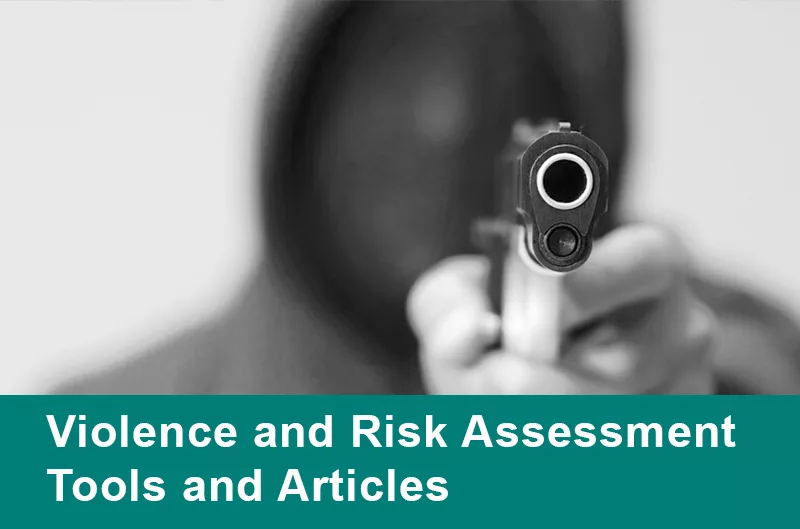Dealing with potentially violent patients is daunting, but we can play an effective role in assessing and reducing violence risk. This post from The Carlat Psychiatry Report links to some key resources.
Risk Assessment Tools
Managing Risk
Psychiatrists must take action if they assess violence risk as high. Here's Dr. Sonkiss's general approach from the article Fighting in the Trenches: A Practical Guide to Violence Risk Assessment and Management:
What to Do About Guns
Whatever you believe about the right to bear arms, access to them increases the risk they’ll be used to violent ends. For that reason, I routinely ask patients if they have guns, then I document a firearm disposition plan that includes education about firearm risks and recommendations for reducing them. Read the full article here.
Risk Assessment Tools
- Classification of Violence Risk (COVR): available at www.parinc.com
- Historical, Clinical, Risk Management (HCR-20): available at www.parinc.com
- Psychopathy Checklist (PCL-R, PCL-SV, PCL:YV): available at www.mhs.com; background information and references available at www.hare.org/scales
- Structured Assessment of Violence Risk in Youth (SAVRY): available at www.parinc.com
- Sex Offender Risk Appraisal Guide (SORAG): available in Quinsey VL et al. Violent Offenders: Appraising and Managing Risk, Second Edition. American Psychological Association; 2005.
- Violence Risk Appraisal Guide (VRAG): available in Quinsey VL et al. Violent Offenders: Appraising and Managing Risk, Second Edition. American Psychological Association; 2005.
- Read more about risk assessment in the article Measuring the Quiet Man: Estimating Risk of Violence.
Managing Risk
Psychiatrists must take action if they assess violence risk as high. Here's Dr. Sonkiss's general approach from the article Fighting in the Trenches: A Practical Guide to Violence Risk Assessment and Management:
- Relax a little: Managing potentially violent patients can be stressful. Try to avoid overreacting to modest risks or hospitalizing to treat your own anxiety. On the other hand, don’t avoid necessary interventions out of fear they might lead to conflict. When in doubt, consult a colleague.
- Develop a safety plan: Discuss with your patient ways to reduce violence risk according to his or her unique circumstances. This may include avoiding triggers, using mindfulness, taking PRN medications, or asking for help, among many others. Include caregivers in the discussion, and document the plan in your notes.
- Change the level of care: Hospitalization may be the best option for high-risk patients who can’t convincingly assure us that they will be safe. For those who can, partial hospitalization or increased frequency of outpatient visits may be sufficient. Frequent telephone check-ins can assess symptoms and adherence to medications. For non-adherent patients, outpatient commitment may be a viable alternative in some states.
- Adjust medications: Symptoms of major mental illness should be treated. Antipsychotics and mood stabilizers can reduce emotional dysregulation and decrease risk of violence even in patients who are not psychotic or manic. For patients with chemical dependency, medications like naltrexone may increase both sobriety and safety.
- Be mindful of medication risks: Some people blame psychiatric medications for violence committed by people with mental illness. This may sound like blaming antihypertensives for heart attacks, but post-marketing surveillance has, in fact, associated some drugs with violent acts. You can search for information about the risks of certain drugs at the website for the Institute for Safe Medication Practices (www.ismp.org).
- Refer: Psychotherapy can be especially beneficial to patients with borderline or narcissistic traits (antisocial, not so much). Chemical dependency treatment is crucial for mitigating violence risk. Few psychiatrists refer to anger management, but I’ve seen such programs turn patients’ lives around.
What to Do About Guns
Whatever you believe about the right to bear arms, access to them increases the risk they’ll be used to violent ends. For that reason, I routinely ask patients if they have guns, then I document a firearm disposition plan that includes education about firearm risks and recommendations for reducing them. Read the full article here.


_-The-Breakthrough-Antipsychotic-That-Could-Change-Everything.webp?t=1729528747)



